#tumor suppressor
Text
USP15: from brain inflammation to cancer, the master-zyme tags the repair and shows itself as a target
USP15: from brain inflammation to cancer, the master-zyme tags the repair and shows itself as a target
Ubiquitin is a highly conserved peptide molecule, composed of 76 amino acids that mark proteins for degradation. Protein ubiquitination changes proteins half-life and tightly regulates the levels of proteins that should be erased before they start to put in danger cellular homeostasis. Ubiquitination often affects protein stability, localization, activity, and interactions, and is widely involved…
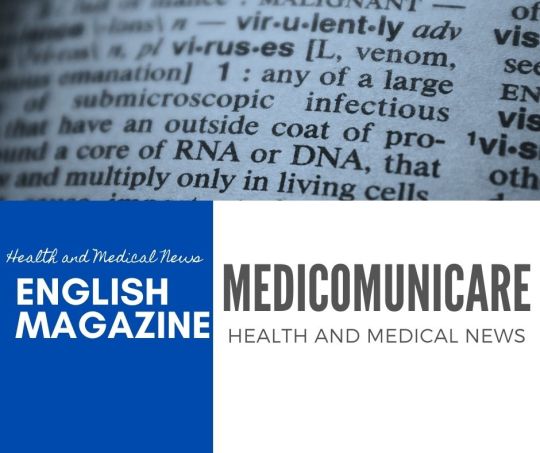
View On WordPress
#anticancer drug#brain cancer#breast cancer#cancer cells#cellular stress#DNA damage#DNA repair#genome integrity#mutation#neuroinflammation#pancreatic cancer#Parkinson disease#tumor suppressor#ubiquitina
5 notes
·
View notes
Text
Mechanism of EGCG binding to p53 revealed: Polyphenolic compounds in green tea may enhance anti-tumor activity by stabilizing p53.
A new study has found that epigallocatechin gallate (EGCG), a polyphenolic compound found in green tea, can induce apoptosis in cancer cells, but its potential molecular mechanisms are not well understood. Recently, a team led by Chunyu Wang at Rensselaer Polytechnic Institute (with China Agricultural University as the first author's affiliation and Jing Zhao as the first author of the paper) published a study in Nature Communications titled "EGCG binds intrinsically disordered N-terminal domain of p53 and disrupts p53-MDM2 interaction". The study used SPR and NMR to report the direct interaction between EGCG and the tumor suppressor p53 (KD = 1.6 ± 1.4 μM), with the disordered N-terminal domain (NTD) identified as the main binding site (KD = 4 ± 2 μM). Large-scale atomic simulations (>100 μs), SAXS, and AUC showed that the EGCG-NTD interaction is dynamic, with EGCG leading to a subpopulation of compact bound conformations. The EGCG-p53 interaction disrupted the interaction between p53 and its regulatory E3 ligase MDM2 and inhibited MDM2-mediated ubiquitination of p53 in vitro, potentially stabilizing p53's anti-tumor activity. Overall, this study provides insights into the anti-cancer mechanism of EGCG and identifies the p53 NTD as a target for cancer drug discovery through dynamic interactions with small molecules.
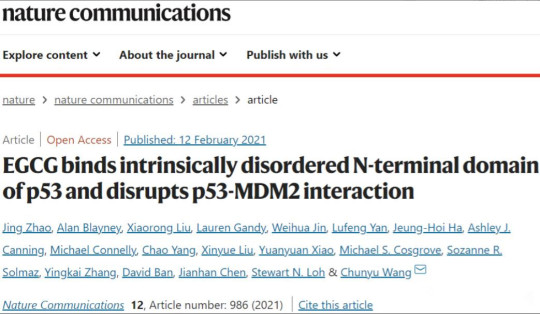
In recent years, diet-based cancer prevention and treatment have received considerable attention. Green tea is a popular beverage worldwide and has been reported to have inhibitory effects on various types of cancers, such as breast cancer, lung cancer, prostate cancer, and colon cancer. Most of the chemopreventive effects of green tea on cancer are attributed to polyphenolic compounds, with epigallocatechin-3-gallate (EGCG) being the most important. EGCG accounts for 50-80% of the catechins in green tea. A cup of brewed green tea (240 mL) contains 200-300 mg of EGCG. A serum concentration of 0.1-1 μM EGCG can be achieved by drinking a cup of green tea or taking an EGCG tablet. The anticancer effects of EGCG have been confirmed in epidemiological, cell culture and animal studies, as well as clinical trials.
A 10-year prospective study by Nakachi and Imai reported that people who drink more than 10 cups of green tea per day have a lower risk of cancer compared to those who drink less than 3 cups per day. Recently, Shin et al. found in a randomized clinical trial in Korea that green tea extract can reduce the recurrence rate of colorectal adenomas by 44.2%. In vitro, EGCG has been shown to promote growth arrest and induce apoptosis in a variety of human cancer cell lines, including prostate cancer cells, epidermoid carcinoma cells, bladder cancer cells, and colon cancer cells.
In mice, oral administration of green tea or intravenous injection of purified EGCG can inhibit angiogenesis and suppress the growth of solid tumors. At the molecular level, EGCG has been shown to interact with cancer-associated proteins, such as glucose-regulated protein 78 (GRP78) and Ras-GTPase-activating protein SH3 domain-binding protein 1 (G3BP1), with an affinity of approximately μM.

In EGCG-induced apoptosis and growth arrest, p53 plays an important role. p53, often referred to as the "guardian of the genome," is a critical tumor suppressor that is mutated in over 50% of human cancers. p53 promotes cell cycle arrest or apoptosis as a response to cellular stress stimuli such as oxidative stress, oncogene activation, and DNA damage. As a transcription factor, p53 is tightly regulated and has a short half-life. p53 protein is typically maintained at low levels in healthy mammalian cells through continuous ubiquitination and subsequent degradation.
Under cellular stress, ubiquitination of p53 is inhibited, and p53 is stabilized. Then p53 accumulates in the cell nucleus and activates the expression of target genes, thereby triggering cell cycle arrest, apoptosis, and DNA repair processes. In addition to serving as a transcription factor, p53 can also be translocated to the cytoplasm or mitochondria. p53 directly interacts with anti-apoptotic proteins such as Bax and Bcl2 to induce apoptosis and also participates in the anti-aging effects of EGCG.
Full-length p53 consists of an N-terminal domain (NTD), a DNA-binding domain (DBD), a tetramerization domain (TET), and a C-terminal regulatory domain (REG). The NTD is further divided into two transcription activation domains (TAD1 and TAD2) and a proline-rich domain (PRD). The NTD is an intrinsically disordered protein (IDP) that interacts with many proteins and serves as a hub for cellular signal transduction. The NTD is not only necessary for transactivation but also interacts with MDM2 to mediate the ubiquitination and degradation of p53.
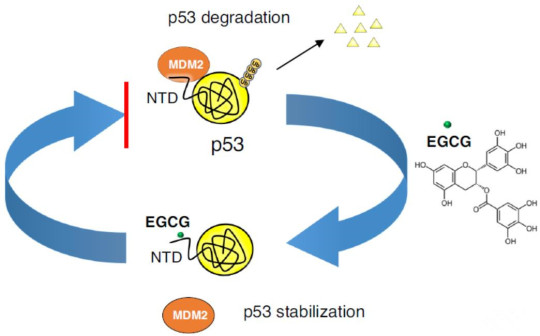
Independent of ubiquitination, MDM2 also inhibits transcription by preventing the general transcription factors from binding to the NTD. The apoptotic effect of EGCG on human cancer cells is related to its interference with MDM2-mediated ubiquitination of p53. It has been reported that EGCG can also stabilize p53 and increase the phosphorylation of critical serine residues. In a recent study, EGCG was identified as an inhibitor of the p53-MDM2 interaction from a library of 2,295 plant chemicals. However, the molecular mechanism by which EGCG disrupts the MDM2-p53 interaction is not yet clear.
In this work, direct binding between EGCG and p53 mediated by the NTD of p53 was demonstrated. The study suggests that the EGCG-p53 interaction disrupts the MDM2-p53 interaction and inhibits the ubiquitination of p53, potentially stabilizing p53's anti-tumor activity and providing a structural mechanism for the anti-cancer effects of EGCG.
#EGCG#tea#green tea#cancer cells#apoptosis#molecular mechanisms#p53#N-terminal domain#tumor suppressor#MDM2#ubiquitination#anti-tumor activity#polyphenolic compounds#chemopreventive effects#epidemiological study#cell culture#animal studies#clinical trials#colorectal adenomas#growth arrest、#angiogenesis#solid tumors#cancer-associated proteins#glucose-regulated protein 78 (GRP78)#Ras-GTPase-activating protein SH3 domain-binding protein 1 (G3BP1)#affinity#growth arrest#cellular stress#DNA damage#transcription factor
1 note
·
View note
Note
Lmao I’m dying over your tags about fruit fly gene names. I listened to an interview with a geneticist who works with C. elegans a while ago and he had major beef with fruit fly geneticists over naming conventions. 😂
you know, I’m beginning to wonder if this isn’t just a normal thing for them. my professor for the developmental biology part of this course is a big drosophila guy and two weeks ago he waxed lyrical about gene naming conventions for it, which was somehow still better than the solid twenty minutes he spent today trying to convince us of drosophila’s superiority as a means of studying development and cancer (presumably as a preface to Thursday’s lesson, where he actually has to talk about c elegans organogeneis experiments). at one point he had to admit that c elegans has a shorter generation time, but he quickly alleviated his own distress by following up that harrowing admission with three minutes of describing how wonderful the Nüsslein-Volhard and Wieschaus experiments were for the study of embryonic development
#i have zero stake in the argument I’m just so so tired of human oncogene and tumor suppressor names#i can’t remember a single pathway except for sonic hedgehog and frankly that one I’d rather forget#asks#biology#anakinsthot#willow's life
13 notes
·
View notes
Text
drinking while doing hw always seems like a good idea and I don’t know how
2 notes
·
View notes
Text
Homunculus Research
(the kinda scientific edition)
Time for me to do the thing that I do where I think way too much about barely explained fictional science and try my best to apply actual science to it. For fun.
So, here is my biological summary for the homunculi of Rain Code, which will be mostly non-canon speculation.
What is a homunculus?
A homunculus is an artificially created, cloned individual using the genetic information of a human for the purpose of developing immortality and regeneration applicable to military use.
What is a homunculus made of and how?
A homunculus is created from gram-negative bacteria and human cells through complete recombinant DNA cloning. This technique is achieved through taking the genes of the human donor and incorporating the information into a bacterial chromosomal DNA and plasmid(the secondary circular DNA molecule of bacteria used for gene replication and transfer). Additionally, the incorporation of the enzyme telomerase and protein p53 is applied.
What contributes to a homunculus's regenerative properties and immortality?
Homunculi exhibit accelerated initial growth and healing thanks to the bacterial hybridization of their cells. Bacteria have one of the fastest replication rates, and can replicate at a rate of about every 10 minutes compared to the average human cell's replication rate of every 24 hours. Gram-negative bacteria also have a complex layering of membrane that allow them to be more resistant to antibiotics and a more sturdy structure. Bacteria have the ability to go through inactivation, where they go into a state of metabolic dormancy that protect them and allow them to be able to wait out periods of extreme conditions and nutrient scarcity.
Telomerase, the 'immortality enzyme', is utilized for its function in restoring the length of telomeres. Telomeres are a protective chromosomal cap that normally erode with each cell division, and it's this shortening that causes DNA damage and aging in humans. Telomerase repairs this erosion and allows cells to divide indefinitely.
However, because of telomerase's link to increased rates of cancer, additional copies of the gene responsible for the production of p53 protein is also incorporated. P53 is a tumor suppressor that allows damaged cells to repair themselves before dividing, which prevents the spread of cancerous cells.
Why is homunculus blood pink?
Gram-negative bacteria is identifiable for its bright pink color by using the gram staining method. This is because the characteristic cell wall structure of gram-negative bacteria which makes them so resilient also causes the bacteria to display the color of the safranin. Homunculus researchers may apply a gram staining process to the circulatory system of homunculi for the purpose of identification and observation.

Relevance of gram-negative bacteria in gene cloning and military research.
The most commonly used strain of bacteria used in gene cloning research is the gram-negative bacteria such as e. coli for its ready availability, ease of growth and manipulation, and simplicity.
Gram-negative bacteria such as e. coli has a history in military research, in cases such as a probiotic when an army surgeon isolated a strain found in a soldier who, unlike his comrades, did not develop an illness from an infectious outbreak.
What is the zombified state of imperfect homunculi?
It is the result of cell inactivation that, while it is a protective measure for the cells, the slowed or halted metabolic state causes the low-functioning mental and physical faculties that present zombie-like symptoms, and is currently difficult to impossible to reverse in imperfect homunculi due to their varying degrees of cellular instability.
Why do imperfect homunculi require compounds found in human flesh for nutrients?
Plasmid stability in DNA cloned cells is often influenced by the original donor's genotype. Imperfect homunculi cells may include defects in the cell division process where the stability of the human DNA contained in the cell plasmid results in incomplete DNA replication, whereas each division causes informational gaps in the gene and interrupt protein synthesis. These gaps can be filled and repaired by taking and incorporating the required information from a healthy human cell through the process of horizontal gene transfer. Human matter must be consumed and broken down in order for the homunculus cells to initiate this process. The lack of these nutrients can cause the homunculus cells to go into a state of inactivation.
Why are imperfect homunculi vulnerable to sunlight?
UV has been known to exhibit antimicrobial effects. Many bacteria, especially gram-negative bacteria, are averse to sunlight. Exposure to the UV radiation in sunlight results in the damage or solar induced inactivation of unstable homunculus cells.
Written, hopefully, as simplified and concise as possible for readability. I feel like I'm forgetting more things I wanted to address, but maybe I'll just leave it here and just make more parts if I think of it :P
#this goes out to the people who would want to put science stuff in their fics but can't think of where to start#if you want elaboration or have questions on other things i could absolutely keep going but this was getting long lol#rain code#raincode#master detective archives: rain code#rain code spoilers#homunculus#rain code homunculus#headcanon#napkin science#homunculus biology
53 notes
·
View notes
Note
Random ask, can I ask what are apoptosis and caspases (in simple terms)?
I have been summoned
(my 'noorie rambles. be very afraid' tag will make so much sense now. I tried to talk about it in a way that's a way that's both engaging and simple. Lots of metaphors.)
Caspases destroy the cell if it needs to die. They dismantle the cell parts as the cell membrane turns into bubbles, containing all the damaged pieces within so that a white blood cell might disposes of them. That's apoptosis in a nutshell.
But why must the cell die you ask?
Plenty of reasons. Human embryos have webbed fingers, and apoptosis causes the webbing to dissipate. Tadpoles too, use apoptosis to rid of their tails so they can become frogs. Apoptosis opposes growth - aka mitosis - and it keeps the body in homeostasis - or a balance of sorts. The destruction to mitosis's creation.

However, what I find most interesting, what is the subject of much research nowadays, and what holds the most opportunity for angsty biology fanfics (most important/j) is that apoptosis opposes tumorigenesis. In other words, if something goes wrong, if the cell gets some notion that it might try to cheat death and live forever, if it has the inklings of an idea to hijack the rest of the body through growing its own lump of cells and draining the body of its nutrients... if it decides to throw a mutiny at the expense of peace...
Then the cellular system realizes, and it activates the caspases.
(Usually how a cell 'decides' is when something wrong happens with genetic replication, mutations and such and such. There are two labels of genes relating to this. Proto-oncogenes promote cell growth and avoid apoptosis - these are the creation genes, the ones that wish to achieve the heights of production and throw all caution to the wind. Whereas tumor suppressor genes are... tumor suppressors. They are the little 'angel on the cell's shoulder' that says 'you've done wrong, now commit cell death and accept your fate'. When a proto-oncogene mutates, it becomes an oncogene. Basically, the genes that said to grow for the sake of the body now says to grow at the expense of the body, the 'devil on the cell's shoulder' won... and now it'll try to cheat death)

Caspases are a type of enzyme, which is a subset of proteins. I like thinking about it like this: enzymes are witches, spell crafters. Proteins in general function like worker bees, but enzymes are the ones who actively create and destroy, the ones that change the way the universe manifests so life can exist. They utilize reactants from their environment - materials which they are named after, such as proteases that cleave other proteins - to either create larger, energy storing molecules (endergonic reactions), or break down large, energy storing molecules to release energy (exergonic reactions).
(One type of enzyme that I like is called kinases, they basically initiate things, they tell the cell 'it's okay to do things' or 'this will be dangerous, let's not do that', or 'oof this cell doesn't have the proper genes, that could be a problem, how about we destroy everything so this doesn't become a big issue?')
When the cell needs to die, the caspases activate.
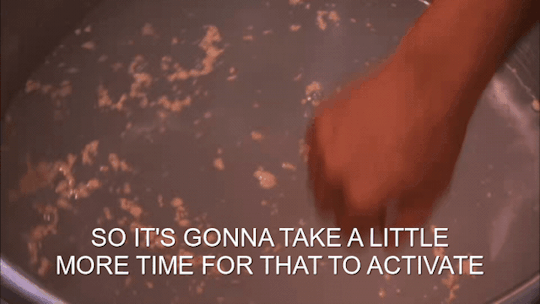
Humans have 14 caspases. I wish I knew what all of them are, but the pub med articles I read do not have a whole list of them like a pokedex from pokemon (at least that I have read so far, after ap testing there's one article I want to read that seems to have ANSWERS to a lot of my questions)
So imagine this, the cell has lots of caspases floating around in the cytoplasm/water jelly environment. These beings of death in huge numbers in a perpetual slumber, just floating around, until the cell decides it needs them to destroy its existence, and it activates them.
(ALTHOUGH some of my questions refer to the "caspase-dependent non-lethal cellular processes", so far what I've been able to find is that if the cell needs some repair to the cytoskeleton/structure of the cell, then it activates a few caspases to destroy parts of it, so that the repair may start.)
There are two types: inflammatory caspases (if I remember correctly, this is caspase 1,4, and... a few others I'll have to check) and apoptotic caspases. What we're interested in are the apoptotic caspases. Initiator caspases get activated first. The way I story-fy them/see them in my head is as the older sibling types who condone violence. If the cell needs to die because of an external signal - a message from far away to destroy itself, to which it must oblige - then caspase 8 activates. If the cell needs to die because of an internal signal - something inside isn't right, and what a havoc it would be to pass that on through replication, so the proteins decide the fate of the world it lives in, and it choses death for the sake of the wider body- then caspase 9 activates.
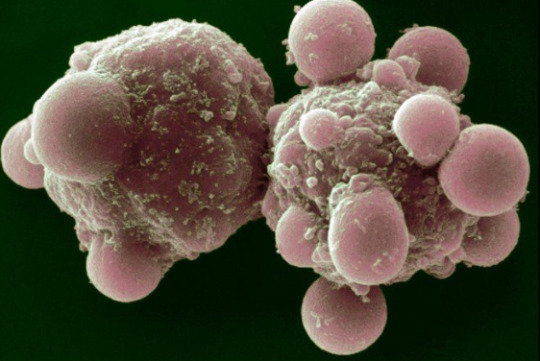
Both these initiator caspases cleave (meaning 'cut', these inactive beasts are not yet 'complete', so they need further modification after activation to work properly. If the cell were to create caspases fully functional and finished, the large number of caspases would kill the entire cell, so they don't finish, they subdue the ones behind their death, and make sure to regulate their slumber.) their 'younger, violent siblings': caspase 7 and caspase 3. The doll I have is a caspase 3.
(I've found more information on them than caspase 7... although.. the one article I found.... it should have information on them all, the amount of searching I've done for those sorts of answers... but alas... I need to read the material for the ap bio exam... which does not include caspases.... one day...)
Caspase 3, as far as I could gather, destroys the cytoskeleton. The cytoskeleton supports the entire cell, acting as the 'tent poles' that keep the floppy cell membrane from collapsing. Collapsing, however, is exactly what the caspase 3 wants. It dismantles the whole thing, along with activating and inactivating a slew of other proteins. (it's an assassin basically.)
And with this, the caspases bow, for the cell is separated within these small little 'blebs' (they look like bubbles) and the cell is destroyed.
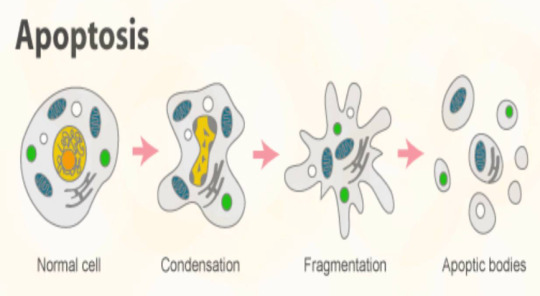
OH AND LAST LITTLE THING!
If something inhibits the caspases, the cell goes through with necrosis, which is basically instead of becoming little bubbles, the cell membrane ruptures and the cell 'guts spill out'
THANK YOU SO MUCH FOR THE ASK!! <3 <3 I got to blabber about caspases and it gave me happy sparkles.
ALSO, here's the doll I made for caspase 3:
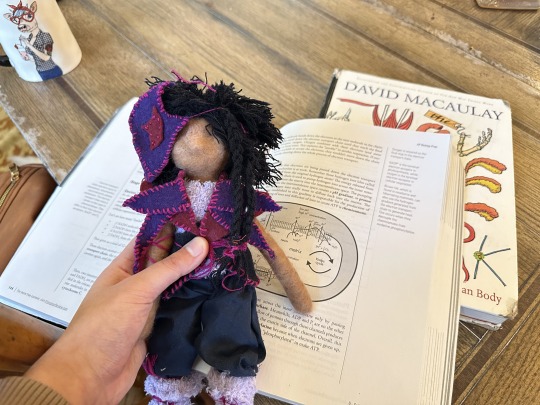
#biology#scientists#science#apoptosis#enzymes#caspases#science side of tumblr#science side of the internet#noorie infodumps. be very afraid#noorie answers asks#lobotomy for my brainrot
7 notes
·
View notes
Text
Elephants rarely get cancer because they have 40 copies of genes that code for the tumor suppressor protein p53 — humans have two.
7 notes
·
View notes
Text
Abstract
Severe acute respiratory syndrome coronavirus 2 (SARS-CoV-2) and COVID-19 infection has led to worsened outcomes for patients with cancer. SARS-CoV-2 spike protein mediates host cell infection and cell-cell fusion that causes stabilization of tumor suppressor p53 protein. In-silico analysis previously suggested that SARS-CoV-2 spike interacts with p53 directly but this putative interaction has not been demonstrated in cells. We examined the interaction between SARS-CoV-2 spike, p53 and MDM2 (E3 ligase, which mediates p53 degradation) in cancer cells using an immunoprecipitation assay. We observed that SARS-CoV-2 spike protein interrupts p53-MDM2 protein interaction but did not detect SARS-CoV-2 spike bound with p53 protein in the cancer cells. We further observed that SARS-CoV-2 spike suppresses p53 transcriptional activity in cancer cells including after nutlin exposure of wild-type p53-, spike S2-expressing tumor cells and inhibits chemotherapy-induced p53 gene activation of p21(WAF1), TRAIL Death Receptor DR5 and MDM2. The suppressive effect of SARS-CoV-2 spike on p53-dependent gene activation provides a potential molecular mechanism by which SARS-CoV-2 infection may impact tumorigenesis, tumor progression and chemotherapy sensitivity. In fact, cisplatin-treated tumor cells expressing spike S2 were found to have increased cell viability as compared to control cells. Further observations on gamma-H2AX expression in spike S2-expressing cells treated with cisplatin may indicate altered DNA damage sensing in the DNA damage response pathway. The preliminary observations reported here warrant further studies to unravel the impact of SARS-CoV-2 and its various encoded proteins including spike on pathways of tumorigenesis and response to cancer therapeutics.
9 notes
·
View notes
Text

Scott McCall's Guide to Become a Vet
Rating : G
Chapters : 1/1
Word Count : 1,384
Characters : Scott McCall, Menace the black cat
Relevant Tags : A Bit of Angst, A Sprinkle of Past Trauma, Scott McCall-centric, Scott McCall is a Sweetheart, And a Student at UC Davis School of Veterinary Medecine, study session
TSG, the flashcard reads.
“Easy,” Scott says aloud, “there’s two categories of tumor suppressor genes: caretaker and gatekeeper.”
Scott flips the card and allows himself a satisfied smile as his answer matches the one on the card. He tosses it to the success pile before looking down at the next one.
Read on ao3
For Scottuary 2024
#scott mccall#menace is scott's cat#and really lives to his name#my boy is gonna be a vet <3#teen wolf#mine
5 notes
·
View notes
Text
Ruth Sager
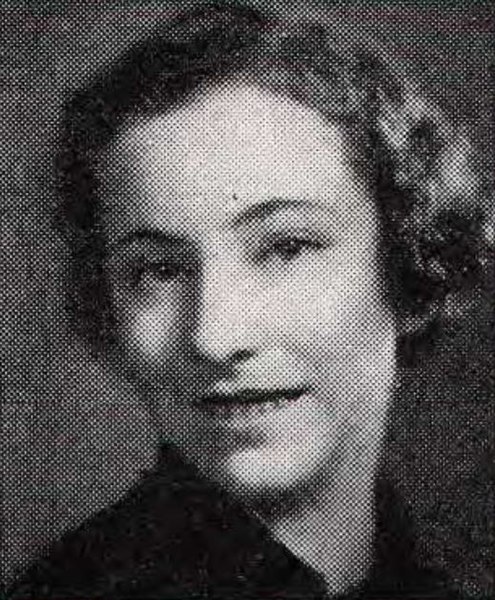
Ruth Sager was born in 1918 in Chicago, Illinois. Sager was a geneticist whose research challenged the widespread view that all genetic information was located in the nucleus of the cell. Later in her career, at Dana Farber Cancer Institute, she conducted research on tumor suppressor genes. Sager was elected to the National Academy of Sciences in 1977.
Ruth Sager died in 1997 at the age of 79.
24 notes
·
View notes
Text
Resisting arrest: ribosomials, oncogenes, tumor suppressors and enzymes coordinate to induce cell suicide in leukemia
Acute lymphoblastic leukemia (ALL) is a highly aggressive cancer. Numerous genetic subtypes of ALL have been identified, including Philadelphia chromosome-positive B-cell ALL (Ph+B ALL) which comprises approximately 25-30% of all adult ALL. Ph+B ALL is characterized by the t(9;22) chromosomal translocation that generates the BCR-ABL1 fusion gene resulting in abnormal tyrosine kinase signaling in…
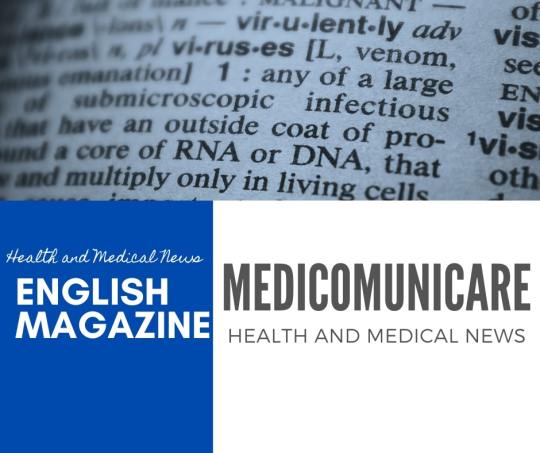
View On WordPress
#acute lymphocytic leukemia#cell nucleus#nucleolar stress response#oncogene#p53#Pidnarulex#programmed cell death#ribosomial biogenesis#RNA polymerase#transcription factor#tumor suppressor#tyrosine kinase
0 notes
Note
I have a malfunctioning tumor suppressor gene. (PTENÂ). It's linked to autism, ADHD, and things growing in and on my body where they aren't supposed to be. I got a three hour scan on my leg which was really really really not fun but it identified a lump there that is benign. There are about 40 thyroid nodules in my thyroid, probably gonna get my thyroid out eventually. Nobody else in my family has this mutation (though my mothers family has a history of thyroid disease). It's classified as rare!
oh holy wow!
3 notes
·
View notes
Text
May have RSV(respiratory syncytial virus), will be going back to the doctors tomorrow for a test bc I was only tested for Covid (there’s a rsv outbreak in my state apparently among Covid and the flu)
It sucks to admit that I’m sickly. My friend is familiar with the disorder I have bc his aunt has it too, and he said she’s sickly like me. And I was like ????.
It didn’t process even as a former bio major that the lack of one of the nervous system tumor suppressors can influence my immune system’s capabilities.
I just thought it was normal to get sick cyclically. February, May, July, November again and again. I used to get repeated sinus infections every single February. It took a lot of care to not catch Covid.
Ik I shouldn’t expect my neurologist to tell me everything about my disorder, but everything is like loosely connected that it’s like “what doesn’t this disorder do?”
(I know the answer which is it doesn’t kill me directly but like if someone with nf1 dies of cancer would you also attribute the lack of neurofibromin 1 as a contributor?)
I should be more proactive and tell her things that seem innocuous, but I don’t know what’s abnormal or not, and I don’t want to make a fuss over nothing.
NF1 isn’t even a disability under the law eyes of the law because half the people with it don’t even display symptoms.
Genetics are so confusing, man.
Polyploidy but only half of the time, genetically dominant but can skip a generation only sometimes. A mutation, but they can predict where on the very large gene that nf1 affects got mutated. What the hell?
So uh, I hope I don’t have RSV, bc apparently for the very sickly it can last weeks up to a whole month possibly more.
Sorry for the vent I’m gonna draw to feel better
#cw illness#nf1#cw vent#it’s a little long please be patient#and I’m using a lot of big words I’m very sorry#I’m just upset because I keep getting sick#normally it’s just colds and sinus infections#and uh#long post#cw Covid mention#I don’t have it tho
4 notes
·
View notes
Text
p53
during shadowkeep through season of the dawn the now *insanely* relevant 'Unveiling' lorebook was released. one of the lorebooks is titled p53.
p53 is a protein of proton weight 47,000 and it is responsible for the cessation of potentially cancerous cells. the voice in the darkness/ winnower posits that it is necessary for life to function, but is also a bomb waiting to detonate:
"Would you tolerate a bomb in your body, waiting to detonate if you deviated from the needs of society?
However, without p53 as an enforcer, the body's utopian surplus of energy becomes a paradise for cancer. Cells cannot resist the temptation to steal from that surplus. Their genetic morality degrades as tumor suppressor genes fail. The only way to stop them is by punishment."
the voice ends the tab positing the question
"Is p53 an agent of the Darkness, or the Light?"
this is a very interesting way to look at p53. and poses to us a concept-- that a thing must necessarily inhibit life in order for more, greater life to continue to exist. now allow me to bring in another, separate concept.
In the 9th entry, "The Wager" , the voice in the dark/winnower states the insanely raw line "You are the gardener's final argument." But more importantly, it states "That wandering refugee [Traveler/Gardener]* chose to make a stand, spend their power to say: "Here I prove myself right. Here I wager that, given power over physics and the trust of absolute freedom, people [you, guardian] will choose to build and protect a gentle kingdom ringed in spears."
i posit that the voice is incorrect, or rather incomplete. it is not that p53 exists as an agent of darkness' will; i instead posit that p53 exists as the aforementioned "ring of spears" against the *true* darkness: cancer. Cancer, by virtue of existence, kills. It is the only thing it knows how to do (though this is framed incorrectly perhaps; cancer only knows how to duplicate, but by duplicating it drains necessary resources, which result in death. to say a cancerous cell is birthed to kill and then die is merely skipping the middle of the syllogism). That sounds, familiar! In "The First Knife" the voice states "And I had only one purpose and one principle in the game. And I could do nothing but continue to enact that purpose, because it was all that I was and ever would be." Seems a little damning, no? But I do not disagree with p53's classification as an element of darkness. It is a bomb. But am I not a bomb? Do I not kill? Have I never snuffed out a consciousness? Contained within my cellular structure is indeed p53.
I posit that the ring of spears is necessarily darkness.
In the final page of the lorebook, I think the Queen of the Reef describes heaven (or at least some place akin to it), and not here. She states, "
Given the choice to live in any world, any world at all… we would need a little Darkness in it, I think, to keep the balance true. But not so much as we would need the Light…"
Understanding this as an ideal, and not a description of reality as fact, the point comes into focus. The light in its current form, exists. To exist is to prove your existence to use the words of another. I think, understanding this ring of spears as a concept of darkness, the Gardener makes its argument. necessarily we must prove that we exist. because to not do so equates to death.
it means that you must prove your right to live against forces who are very eager to demand proof.
That ring of spears, it is starting to drip with epistemological proof.
The final shape is the paring back of all that can be. That which remains when all that can be removed, has been removed. That which remains after it has been winnowed; after the garden has been tended to. That beautiful, final shape of the garden. Of the flowers and the hedges, the full completion, perfected. In layman's terms, it is the extermination of all life that cannot prove its existence. That cannot prove its *right* to live | exist. That is the philosophy of the final shape. Of the Darkness. or at the very least, all of our enemies right now :)c .
Let us pare back of the darkness what we need. That epistemological proof. That right to exist. That ring of spears.
p53, nuclear weight of 47000, is an element of the darkness;
however, to understand p53 as an *agent* of the darkness is to misunderstand its purpose. That is why I believe the voice is incorrect.
To understand the ring of spears as an agent of the darkness is to misunderstand its purpose.
~~~~~~~
*[the familiarity conjured by 'wandering refugee' seems to directly refer to the Traveler, as opposed to the ideological Gardener which really makes me doubt if this is the winnower, and not some force beyond (maybe this is the witness speaking?). then again the nonchalance the voice brings to the table, "my man oryx", for example, suggests power, almost? i dont know how to properly describe it. the way that this voice speaks to us is this bizarre realm of nonchalance and it almost even feels like condescension at points which feels almost like the point but i dont understand the point that it is trying to make]
...is the name of this lore book supposed to be a pun on 'the veil'...?
also on the wikipedia page for p53 it says

and that feels pretty on the nose
#figure ill put this here too#i want to be a destiny loremaster#the final shape#destiny 2#destiny 2 lore#unveiling
3 notes
·
View notes
Text

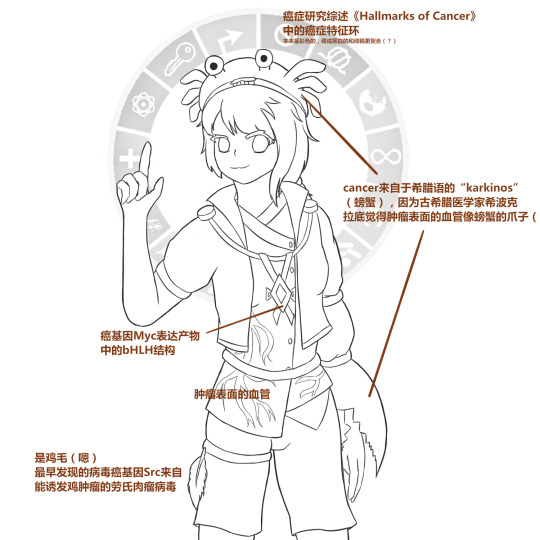
<Cancer Biology SE>
Real Name: Cancibio
Name for External Situation: Crabinoma/谢炎
Other Name: Cancie/Miss Crab
Constellation: Cancer
Entity Gotten Time: ancient Greece (unproven)
More Info:
She likes to wear the crab hat when in casual occasions. The ring of 'hallmarks of cancer' on her back is a holographic projection, and the projection device is hidden in her clothes.
2.She likes to eat chicken.
She works as a researcher in the human society, working closely with genetics SE (an abbreviation of Subject Entity) and others, occasionally going to hospitals to do odds and ends.
4.She is a proto-oncogene lover, but she likes tumor suppressors as well (though to a lesser extent).
In spare time, she also plays games, and is a game master among life science SE. She knows how to upgrade skills properly and develop her influence safely and secretly.
She is very observant and always notices of details.
7.Perhaps she has a spirit of resistance in her minds - that resists the pessimism of "incurable disease", and the mighty "emperor of all maladies". For centuries, she has encountered numerous know how many obstacles and misunderstandings. But she does not mind it because of her firm goal - do "regicide" together with human beings, so that the unbeatable tyrant becomes history.
7 notes
·
View notes
Text
Why "Prevention is better than Cure" prove most suitable in the case of Cancer?

Since our childhood, we have always heard that " Prevention is better than Cure". What is exactly the message in this? What is your understanding? Before digging down into the details let’s move forward to understand these two words first – Prevention & Cure.
Prevention: Prevention is all about your status of being healthy, happy, and independent as long as possible; that means reducing the chances of any problems or challenges before the same may be expected. There is no age restriction applicable in the case of Prevention. It hardly matters what physical age you are in? This is truly vital for an old person and at the same time for a young person. What we need is to educate people by sharing proper information, build their skills and boost their confidence so that they have control of their life and health.
Cure: Cure is about all the external procedures which are required to minimize the damage done by factors which you are not able to prevent in the first place. A cure is a substance or procedure that ends a medical condition, such as a medication, a surgical operation, a change in lifestyle, or even a philosophical mindset that helps end a person's sufferings; or the state of being healed or cured. The medical condition could be a disease, mental illness, genetic disorder, or simply a condition a person considers socially undesirable, such as baldness or lack of breast tissue. (Credit: Wikipedia).
Now, we are in the position to safely jump on the Subject Why "Prevention is better than cure" proves most suitable in the case of Cancer? Prevention is always better than cure as prevention stop the damage while cure tries to recover the damage which is never 100%.
Every cure has leftovers in one or another way. Especially if we talk about Cancer. Cancer is still a deadly word among societies. Cancer is a disorder of tissues in which irregular cells divide violently and destroy surrounding body tissue. The destruction always is damage! No matter how worth your cure is, the damage is confirmed.

To understand what positive effect the prevention will impact on our health, let me guide you through the details of Cancer. Cancer a name was given to the set of related diseases. In every Cancer, some of the body cells or tissues start to divide uncontrollably and start spreading into the surrounding cells or tissues.
Cancer can make its appearance in any part of the body. A solid tumor (mass of tissues) can be easily noticed; however, the other form of Cancer like Blood Cancer is hard to detect, as there will not be a visible external sign.
Normally whenever our body demands, human cells start growing and divide to form new cells. Same way when they become old or damaged they die and new cells take their place.
Cancerous cells are malignant, which means they can spread into nearby tissues. Also, they can travel to the other parts of the body through the blood or the lymph system and may form new Cancer tumors at the new place.
Difference between Normal Cells and Cancer Cells
There is much distinguishable difference between Normal and Cancer Cells. Normal Cells grow mature and stop with a specific function whereas Cancer cells are not specialized and continue to grow (divide) without stopping.
Cancer cells are influencers of Normal Cells and can induce nearby normal cells to form a tumor. Cancer cells can also attack the immune system however; the immune system of a body normally removes damaged or abnormal cells.
How Cancer Starts
Cancer can be caused genetically which means you may inherit them from your parents. They can also arise during a person’s lifetime caused by certain environmental factors like smoking or chewing tobacco, ultraviolet radiation, etc.
Drivers of Cancer
The genetic changes that contribute to Cancer mainly tend to affect three main types of genes proto-oncogenes, tumor suppressor genes, and DNA repair genes, which are known as Drivers of Cancer.
Proto-oncogenes are normal cell growth and division. However, they may become Cancer-causing genes (or oncogenes), when these genes are altered in certain ways or are more active than normal; it allows cells to grow and survive when they are not supposed to.
The Tumour suppressor genes also control cell growth and division. The cells with fixed variations in tumor suppressor genes can divide in an uncontrolled manner.
DNA repair genes are involved in the maintenance of damaged DNA. Cells with mutations in DNA repair genes tend to evolve secondary mutations in other genes. Together, these transformations may cause the cells to become cancerous cells.
Metastatic Cancer
Cancers that spread from one place to other places are known as Metastatic Cancer and the process is known as Metastatic. They have the same name and type as the original Cancer. Treatment may help to increase the lives of few people with metastatic Cancer. In general, most people who die of Cancer die of metastatic disease.
All tissue changes are not Cancer; however if not diagnosed and treated, may develop into Cancer. Below are some examples of tissue changes.
Hyperplasia
When cells within a tissue divide rapidly than the normal rate and additional cells build up. However, these cells or the tissue look regular under a microscope. Hyperplasia may have occurred because of several factors such as chronic irritation.
Dysplasia
It is a more severe condition than hyperplasia. In dysplasia, the extra cells look more irregular and there are changes in the way how the tissue is arranged. As a rule, the more irregular the cells and tissue look, the greater likelihood is that Cancer will form. An example of dysplasia is an abnormal mole on the skin.
Types of Cancer
To date, there are 100+ types of known Cancer. Cancer is usually categorized and named for the organs or tissues affected. For example, lung Cancer affects cells of the lung, breast Cancer affects the cells of the breast, and brain Cancer affects the cells of the brain.
Below is the list of such few Cancer categories that affect a specific type of cell or tissue,
Carcinoma: This is the most common type of Cancer and starts in the epithelial cells of the skin or in the cells that line the internal organs such as the liver and kidneys. There are many types of epithelial cells, which have a column-like shape when observed under a microscope.
Different epithelial cell types have specific names based on Carcinomas origin,
Adeno Carcinoma: It is a Cancer that produces fluids or mucus. Tissues having such epithelial cells are also known as glandular tissues. Cancers of the prostate, breast, and colon most are adenocarcinomas.
Basal Cell Carcinoma: It is a Cancer that originates in the lower or basal layer of the epidermis, which is the outer layer of skin.
Squamous Cell Carcinoma: It is a Cancer that lies just beneath the outer surface of the skin. Squamous cells also attack many other organs, including the stomach, intestines, lungs, bladder, and kidneys. Squamous cells look flat when observed under a microscope. They are called epidermoid carcinomas.
Transitional Cell Carcinoma: It is a type of epithelial tissue (transitional epithelium, or urothelium). This tissue is made up of several layers of epithelial cells and is found in the part of the kidneys (renal pelvis), ureters, linings of the bladder, and a few other organs. Cancers of the bladder, ureters, and kidneys are known as transitional cell carcinomas.
Sarcoma: Cancers that form in bone and soft tissues are Sarcomas, This is also found in muscle, fat, blood vessels, lymph vessels, and fibrous tissue (such as tendons and ligaments).
Osteosarcoma: This is the most known Cancer of the bone. The popular types of soft tissue sarcoma are dermatofibrosarcoma protuberans, Kaposi sarcoma, leiomyosarcoma, liposarcoma, and, malignant fibrous histiocytoma.
Leukemia: Cancers that originate in the blood-forming cells of the bone marrow are known as leukemia. These Cancers do not form any solid tumors. But large numbers of abnormal WBC grow up in the blood and bone marrow. This abnormal growth of WBC causes a low level of normal blood cells and makes it difficult for the body to get oxygen to its tissues, control bleeding, or fight infections.
Lymphoma: This starts in lymphocytes (T cells or B cells). These are disease-fighting WBC that are part of the immune system. In this, irregular growth of lymphocytes seen in lymph nodes & lymph vessels, and also in other parts of the body.
There are two main types of Lymphoma,
Hodgkin Lymphoma – People suffering from this disease have irregular lymphocytes that are called Reed-Sternberg cells. These cells usually form from B cells.
Non-Hodgkin Lymphoma – This is a large set of Cancers that start in lymphocytes. Such Cancers can expand very quickly or slowly and may be formed from B cells or T cells.
Multiple Myeloma: Multiple myeloma originates in plasma cells. This is another type of immune cell. The myeloma cells build up in the bone marrow and form tumors in bones all through the body. Other nomenclature of Multiple myeloma is plasma cell myeloma and sometimes Kahler disease.
Melanoma: Melanoma, (melanocytes), which are specialized cells that make melanin (the pigment responsible for skin color). Mainly melanomas grow on the skin, but they can also grow in other pigmented cells, such as the eye.
Most common people do not understand the above explanation related to Cancer. So I am quoting the list of most common Cancer categories that affect a specific organ in the Human body.
Breast Cancer: Cancer that grows and affects the cells of the breasts. Though it is a common type of Cancer in women, also may be rarely found in men. It is also very common to get inherited breast Cancer as the gene mutations are passed through generations of family. You can easily diagnose the abnormality or symptoms of breast cancer on your own.
Wonder, how to examine at home? Start with a firm, soft, and, smooth touch with the first few fingers of your hand, hold your fingers flat and together. Rotate your hands in a circular motion, about the size of a quarter. Now cover the entire breast with your palm side by side and then from top to bottom. Did you notice any changes? Examine again from your collarbone to the top of your abdomen, and then repeat the same from your armpit to your cleavage to identify any unusual growths or symptoms.

Blood Cancer: This is also known as Leukaemia which is a group of Blood Cancers that normally grows in the bone marrow and result in the huge growth of abnormal WBC. Various types of Leukaemia exist such as acute lymphoblastic leukemia, acute myeloid leukemia, and chronic lymphocytic leukemia. Leukemia can affect Children and Adults both.
Cervical Cancer: A malignant tumor of the cervix, the lowermost part of the uterus that connects to the vagina. The most common cause of this type of Cancer is various strains of the Human Papilloma Virus (HPV), a sexually transmitted infection. Typically, the body’s immune system fights and prevents the harm caused by the HPV, still, this virus survives for many years and may cause normal cells to Cancer cells.
It is very difficult to diagnose Cervical Cancer at its early-stage as there is generally no signs or symptoms; however diagnosis may be possible at the more advanced level of Cervical Cancer.
Oral Cancer: Any type of Cancer that develops in any part of the mouth including the lips, tongue, gums, cheeks, top and bottom floor of the mouth, hard and soft palate, sinuses, and pharynx (throat). These are very common and also life-threatening if not diagnosed and treated properly. In the early stage, this normally causes any pain. However, in the advanced stage, the Cancer sore may appear white, grey, or yellow, and the edges are red. Most oral Cancers are of type squamous cell carcinoma and tend to spread very quickly. Although Oral Cancer can develop at any age however people older than 45 have an increased risk for oral Cancer
Other common types of Cancer are:
Prostate Cancer: An abnormal growth in a man's prostate.
ü Skin Cancer (Melanoma): The most dangerous type of skin Cancer.
ü Colon Cancer: This Cancer grows in the colon or rectum.
ü Lung Cancer: This type of Cancer affects the lungs and is most common in people who smoke.
Now you surely can be educated and informed enough that you can analyze the threats if caused by Cancer.
We, Cancer Samiksha, feel what you feel” and, strongly believe that “Prevention is better than Cure”. A second opinion could be a lifesaving step if available at the right time. The second opinion is the way of getting Cancer treatment advice from more than one place. All you might be aware of that getting a second opinion on Cancer is normally a time-consuming activity, as it requires you to travel and stay in other cities to get the best advice on Cancer treatment. This also is not a pocket-friendly step.
So, We, Cancer Samiksha, offer you an online Second opinion option with your fingertips. This drastically reduces your overall time to 48 hours and also saves your pocket as you need not visit and stay.
Cancer Samiksha has a team of 40+ experts (Oncologists) of their domain who are always ready and happy to offer consultation through individual or panel advice. You may get a second opinion at any stage of your Cancer treatment. Getting expert advice at Cancer Samiksha is a user-friendly series of a few mandatory steps where you need to upload your reports along with the necessary details.
We, at Cancer Samiksha, value your time and share online Cancer consultations within 48 hours of uploading your reports. You may also speak with your consulting Doctor through video calling.
So, during your Cancer treatment journey, whenever you think that “Are you getting the Best Cancer Treatment”? Feel free to Connect with Cancer Samiksha as “We feel what you feel”. You will get the best Second opinion on Cancer treatment!
If you resonate with the information provided here, connect me on -
Participate in a Cancer risk analysis self-assessment mission free:
Join Our Telegram Channel for regular updates on cancer - https://t.me/+kYNaOIqQKzJjYzA1
Join What’s App Group for regular updates on cancer - http://bit.ly/2EFQRtZ
Click to join our FB Page - https://www.facebook.com/CancerSamiksha
We are available on what’s app - 98814 00 500
It was great sharing my thoughts “Be safe, please don’t step out unless it is extremely important, and wash your hand regularly. Take special care of senior citizens."
.
Best Wishes
Ajay Balai
CEO – Cancer Samiksha (Powered By – Universal Cancer Conquest UCC)
P.S. If you share this blog, it will make my day awesome!
2 notes
·
View notes